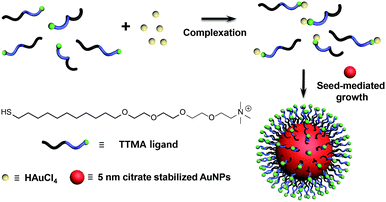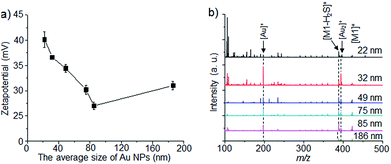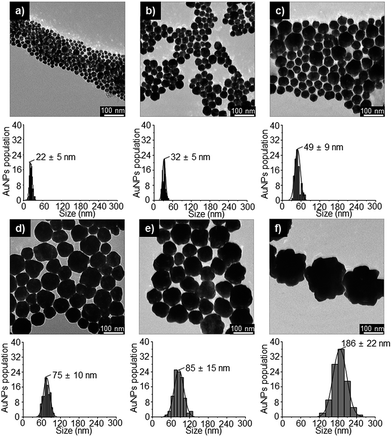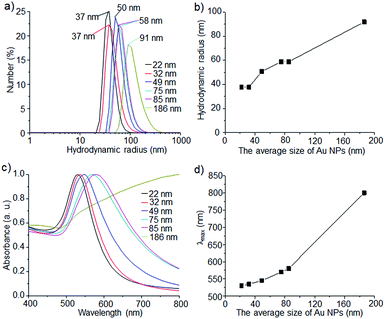Facile synthesis of cationic gold nanoparticles with controlled size and surface plasmon resonance†
Young-Kwan Kimab,
Ryan F. Landisa,
Shuaidong Huoac,
Chang Soo Kima,
Richard W. Vacheta and
Vincent M. Rotello*a
aDepartment of Chemistry, University of Massachusetts, Amherst, MA 01003, USA. E-mail: rotello@chem.umass.edu
bCarbon Convergence Materials Research Center, Institute of Advanced Composite Materials, San 101, Eunha-ri, Bongdong-eup, Wanju-gun, Jeollabuk-do, 565-905 Korea
cChinese Academy of Sciences (CAS) Key Laboratory for Biological Effects of Nanomaterials and Nanosafety, National Center for Nanoscience and Technology, No.11, First North Road, Zhongguancun, Beijing, 100190, China
First published on 31st August 2016
Abstract
We present a facile synthetic strategy for large cationic gold nanoparticles by utilizing a cationic thiol ligand as a stabilizer for seed-mediated growth. The size and surface plasmon resonance property of the gold nanoparticles were successfully controlled with this strategy.
Gold nanoparticles (AuNPs) have been used for a wide range of applications, including drug and gene delivery,1 photothermal therapy,2 bioimaging,3 biosensing,4 and plasmonics.5 The surface plasmon resonance (SPR) property of AuNPs play a pivotal role by enabling energy harnessing over a wide range of wavelengths to locally generate heat, photoacoustic signals, and enhance electromagnetic fields.6 The SPR property of cationic AuNPs is particularly significant for their biomedical and plasmonic applications, because they enable gene and drug delivery into mammalian cells7 and form photonic crystals, respectively.8 Since the SPR property of AuNPs is closely related to their size, shape, and inter-particle distance,9 improved synthetic strategies for cationic AuNPs will increase the utility of these systems.10,11
There are two conventional approaches for the preparation of cationic AuNPs: direct reduction of gold salts in the presence of cationic ligands12,13 or polymers,14–16 and place exchange reactions of pre-synthesized AuNPs.17 The former method is relatively simple but to date has only enabled the synthesis of small (<20 nm) cationic AuNPs with broad size distributions12–16 because of unwanted reduction and decomposition of cationic ligands by strong reductants.17 The latter method provides a narrower size distribution, but it has only been applied to small AuNPs (1.5 to 6.0 nm) and has complications during place exchange procedures, including the requirement for substantial amounts of ligand to drive the equilibrium.18 Since the SPR property of AuNPs can be enhanced by increasing the size,9 it is desirable to develop a facile size-controllable synthetic strategy of cationic AuNPs. Recently, a two-step phase transfer method for ligand exchange was developed to prepare cationic AuNPs with sizes between 8 and 20 nm.19 However, this method is challenging for AuNPs > 20 nm due to irreversible aggregation by electrostatic interactions between the anionic particle and cationic ligands.
Herein, we report a simple and efficient one-step seed-mediated growth strategy to synthesize size-controllable cationic AuNPs (Scheme 1). For the seed-mediated growth, we utilized a thiol ligand with a quaternary ammonium head group (TTMA ligand) designed to provide stability and water solubility to the AuNPs.20 The design of the TTMA ligand, in particular the oligo(ethylene glycol) segment, prevents aggregation of AuNPs induced by cationic quaternary ammonium terminal groups during synthesis and renders it more suitable for the synthesis of cationic AuNPs for biomedical applications than quaternary ammonium surfactants typically used for the synthesis of cationic Au nanorods,21 Au nanostars,22 and AuNPs.23
 | ||
| Scheme 1 Schematic illustration of the synthetic process of cationic AuNPs by a seed-mediated growth process. | ||
For the synthesis of seed AuNPs, we reduced HAuCl4 with NaBH4 in the presence of citrate at room temperature producing 5 nm sized AuNPs stabilized by citrate.24 (For characterization of this AuNP, see Fig. S1 in ESI†). These negatively charged AuNPs were then used for seed-mediated growth. For the preparation of growing solutions, 250 μL of 10 mM TTMA ligand, 500 μL of 10 mM HAuCl4 and 1 mL of 10 mM ascorbic acid were added to 4 mL of water. Ascorbic acid was selected as a reductant for the seed-mediated growth because of its mild reduction properties, minimizing potential reduction and decomposition of the stabilizing TTMA ligand during the growth reaction. Finally, 100 μL of 600 nM seed AuNP suspension was added to the growing solution to initiate the seed-mediated growth. After addition of the seeds into the growing solution, the colorless solution immediately became reddish, indicating the progression of seed-mediated growth. Transmission electron microscopy (TEM) analysis revealed that 15 nm AuNP was successfully synthesized by this initial seed-mediated growth experiment (Fig. 1a).
We next examined how the seed concentration influences the size of AuNPs by adding 100 μL of AuNP seed solutions (600, 60, 30, 10, 5 and 1 nM) to each growing solution. The average size of cationic AuNPs increased from 22 ± 5 to 186 ± 22 nm (TEM) with decreasing concentration of seed NPs (Fig. 1), which was consistent with the literature on the seed-mediated growth of AuNPs.25 Decreasing the concentration of seeds changed the shape of cationic AuNPs from spherical to polygonal shape (Fig. 1). This result matches previous reports that isotropic growth of cationic AuNPs changed into anisotropic growth with decreasing concentration of seeds.26 Based on this result, we concluded that the AuNPs were synthesized through a seed-mediated growth process by reduction of AuCl4− ions on the surface of the seeds. As a control, the growth reaction was conducted without seeds and this reaction resulted in the formation of large and irregular chunks (Fig. S2†). For the detailed elucidation of the role of seeds in the growth reaction, the evolution and change of SPR property during the synthesis of AuNPs were monitored with and without seeding (3 pmol). In the presence of seed, an SPR band appeared around 549 nm after 1 min growth reaction and red-shifted to 553 nm as reaction proceeded. On the other hand, a typical SPR band of AuNPs was not observed in the unseeded control experiment. There was only broad absorption in overall visible region that also increased as reaction proceeded. This difference in outcome clearly indicated the role of seeds for inducing preferential reduction of Au ions on their surface for the formation of large cationic AuNPs (Fig. S3†).
To examine the dispersibility of the cationic AuNPs, the hydrodynamic radius (rH) of cationic AuNPs dispersed in water was characterized by dynamic light scattering (Fig. 2a and b). The rH values of cationic AuNPs are shown in Fig. 2a and b. There were no signs of aggregation, confirming that the cationic AuNPs were successfully synthesized and well dispersed in aqueous media.
The SPR properties of the cationic AuNPs were characterized by UV-Vis spectroscopy. The cationic AuNPs clearly exhibited a SPR band in each absorption spectrum (Fig. 2c) with the maximum absorption wavelength (λmax) red-shifting as the concentration of seeds decreased (Fig. 2d). The λmax of cationic AuNPs were 530, 535, 545, 570, 580 and 800 nm for the AuNPs synthesized with 60, 6, 3, 1, 0.5 and 0.1 pmol of seed, respectively. Although the degree of SPR red-shift of AuNPs differed somewhat from the theoretical expectations owing to the size and shape distribution of AuNPs, the red-shift tendency of λmax with size increase was correlated with the results of TEM analysis and literature (Fig. 1).9
To characterize the surface properties of the AuNPs, the zeta potentials of AuNPs were analyzed. As expected, all of the AuNPs possessed highly positive charge, with zeta potential increasing with increasing number of seeds (Fig. 3a). This tendency suggested that the zeta potential value increased with the surface area of cationic AuNPs. The AuNPs synthesized with 0.1 pmol seed deviated from this tendency, presumably because of their rough surface compared to the AuNPs synthesized with 0.5 pmol seed. The positive zeta potential values supported successful functionalization of the AuNPs with the TTMA ligand.
 | ||
| Fig. 3 (a) Zeta potential values and (b) mass spectra of cationic AuNPs synthesized with different amounts of seed in each growing solutions (60, 6, 3, 1, 0.5 and 0.1 pmol). | ||
To demonstrate the presence of TTMA ligand on the cationic AuNPs, all of the AuNPs were analyzed by laser desorption/ionization mass spectrometry (LDI-MS), one of the efficient analytical methods to characterize surface ligands on AuNPs.27 Mass spectra of all cationic AuNPs showed the characteristic mass peaks of TTMA ligand (M1) at m/z 388 [M1 − H2S]+ and m/z 422 [M1]+ and gold ion clusters at m/z 197 [Au]+ and m/z 394 [Au2]+ (Fig. 3b).28 Taken together, we conclude that cationic AuNPs functionalized with TTMA ligand were successfully synthesized with a controlled size and their corresponding SPR properties by this seed-mediated growth strategy.
In summary, we have developed a facile seed-mediated growth strategy of large size cationic AuNPs by utilizing the cationic thiol ligand, TTMA. The size and SPR property of cationic AuNPs were respectively controlled in the wide range from 22 ± 5 to 186 ± 22 nm in diameter, and 530 to 800 nm by simply changing the concentration of seeds during the growing reaction. We believe that the present synthetic strategy will be a useful avenue for the synthesis of large size cationic AuNPs for biomedical applications.
Acknowledgements
Financial support was provided by the NIH (GM077173) and the NSF (CHE-1506725).Notes and references
- S. Rana, A. Bajaj, R. Mout and V. M. Rotello, Adv. Drug Delivery Rev., 2012, 64, 200 CrossRef CAS PubMed.
- Y. Wang, K. C. Black, H. Luehmann, W. Li, Y. Zhang, X. Cai, D. Wan, S. Y. Liu, M. Li, P. Kim, Z. Y. Li, L. V. Wang, Y. Liu and Y. Xia, ACS Nano, 2013, 7, 2068 CrossRef CAS PubMed.
- I. H. El-Sayed, X. Huang and M. A. El-Sayed, Nano Lett., 2005, 5, 829 CrossRef CAS PubMed.
- K. Saha, S. S. Agasti, C. Kim, X. Li and V. M. Rotello, Chem. Rev., 2012, 112, 2739 CrossRef CAS PubMed.
- A. Teulle, M. Bosman, C. Girard, K. L. Gurunatha, M. Li, S. Mann and E. Dujardin, Nat. Mater., 2015, 14, 87 CrossRef CAS PubMed.
- O. Neumann, C. Feronti, A. D. Neumann, A. Dong, K. Schell, B. Lu, E. Kim, M. Quinn, S. Thompson, N. Grady, P. Nordlander, M. Oden and N. J. Halas, Proc. Natl. Acad. Sci. U. S. A., 2013, 110, 11677 CrossRef CAS PubMed.
- G. D. Moon, S. W. Choi, X. Cai, W. Li, E. C. Cho, U. Jeong, L. V. Wang and Y. Xia, J. Am. Chem. Soc., 2011, 133, 4762 CrossRef CAS PubMed.
- N. Pazos-Perez, C. S. Wagner, J. M. Romo-Herrera, L. M. Liz-Marzán, F. J. García de Abajo, A. Wittemann, A. Fery and R. A. Alvarez-Puebla, Angew. Chem., Int. Ed., 2012, 51, 12688 CrossRef CAS PubMed.
- K. L. Kelly, E. Coronado, L. L. Zhao and G. C. Schatz, J. Phys. Chem. B, 2003, 107, 668 CrossRef CAS.
- (a) S. Link and M. A. El-Sayed, J. Phys. Chem. B, 1999, 103, 4212 CrossRef CAS; (b) E. Oh, K. Susumu, R. Goswami and H. Mattoussi, Langmuir, 2010, 26, 7604 CrossRef CAS PubMed.
- (a) X. Ji, X. Song, J. Li, Y. Bai, W. Yang and X. Peng, J. Am. Chem. Soc., 2007, 129, 13939 CrossRef CAS PubMed; (b) O. Uzun, Y. Hu, A. Verma, S. Chen, A. Centrone and F. Stellacci, Chem. Commun., 2008, 196 RSC.
- T. Niidome, K. Nakashima, H. Takahashi and Y. Niidome, Chem. Commun., 2004, 1978 RSC.
- (a) J. J. Li, N. Kawazoe and G. Chen, Biomaterials, 2015, 54, 226 CrossRef CAS PubMed; (b) F. Aldeek, M. A. Habeeb Muhammed, G. Palui, N. Zhan and H. Mattoussi, ACS Nano, 2013, 7, 2509 CrossRef CAS PubMed.
- M. Thomas and A. Klibanov, Proc. Natl. Acad. Sci. U. S. A., 2003, 100, 9138 CrossRef CAS PubMed.
- F. S. Mohammed, S. R. Cole and C. L. Kitchens, ACS Sustainable Chem. Eng., 2013, 1, 826 CrossRef CAS.
- L. H. Peng, J. Niu, C. Z. Zhang, W. Yu, J. H. Wu, Y. H. Shan, X. R. Wang, Y. Q. Shen, Z. W. Mao, W. Q. Liang and J. Q. Gao, Biomaterials, 2014, 35, 5605 CrossRef CAS PubMed.
- I. Ojea-Jiménez, L. García-Fernández, J. Lorenzo and V. F. Puntes, ACS Nano, 2012, 6, 7692 CrossRef PubMed.
- (a) C. S. Kim, N. D. B. Le, Y. Xing, B. Yan, G. Y. Tonga, C. Kim, R. W. Vachet and V. M. Rotello, Adv. Healthcare Mater., 2014, 3, 1200 CrossRef CAS PubMed; (b) J. B. Tracy, M. C. Crowe, J. F. Parker, O. Hampe, C. A. Fields-Zinna, A. Dass and R. W. Murray, J. Am. Chem. Soc., 2007, 129, 16209 CrossRef CAS PubMed.
- J. Hassinen, V. Liljeström, M. A. Kostiainen and R. H. Ras, Angew. Chem., Int. Ed., 2015, 54, 7990 CrossRef CAS PubMed.
- D. F. Moyano and V. M. Rotello, Langmuir, 2011, 27, 10376 CrossRef CAS PubMed.
- T. K. Sau and C. J. Murphy, Langmuir, 2004, 20, 6414 CrossRef CAS PubMed.
- C. Hrelescu, T. K. Sau, A. L. Rogach, F. Jäckel, G. Laurent, L. Douillard and F. Charra, Nano Lett., 2011, 11, 402 CrossRef CAS PubMed.
- T. K. Sau and C. J. Murphy, Langmuir, 2005, 21, 2923 CrossRef CAS PubMed.
- Y.-K. Kim and D.-H. Min, Langmuir, 2012, 28, 4453 CrossRef CAS PubMed.
- N. Jana, L. Gearheart and C. J. Murphy, Langmuir, 2001, 17, 6782 CrossRef CAS.
- Y.-K. Kim, H.-K. Na and D.-H. Min, Langmuir, 2010, 26, 13065 CrossRef CAS PubMed.
- Z.-J. Zhu, V. M. Rotello and R. W. Vachet, Analyst, 2009, 134, 2183 RSC.
- Z.-J. Zhu, P. S. Ghosh, O. R. Miranda, R. W. Vachet and V. M. Rotello, J. Am. Chem. Soc., 2008, 130, 14139 CrossRef CAS PubMed.
Footnote |
| † Electronic supplementary information (ESI) available: Experimental details and additional characterization results. See DOI: 10.1039/c6ra20419h |
| This journal is © The Royal Society of Chemistry 2016 |


